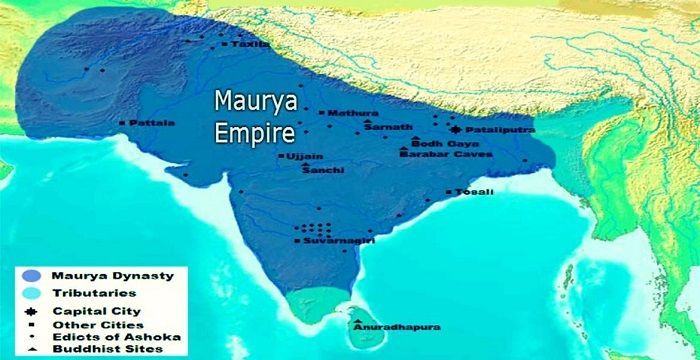Maurya Empire
Jul 01, 2019 • 8 views
Chandragupta established the Maurya Empire in around 321 BC, after overthrowing the Nanda king in Magadh.
"Chandragupta (321-297 BC) was the founding father of the Maurya Empire in the ancient republic of India. Heengineeredone among the largest-ever empires on the Indianlandmassthen, in step withJainsources, he renounced it all and have become Jain monk. Historicalfaithtexts claim Chandragupta followed Jainism by initial renouncing his wealth and power, effort with Jaina monks, and activity ritual of peacefully hospital death by fast.Chandragupta's life and accomplishments unit diagrammatically ancient Hindu, Buddhist, and Greek texts, however the small print vary considerably from those within the Jain texts."Megasthenes served as a Greek ambassador in his court for four years.""
"According to varied legends, Chandragupta, with the counsel of his Chief Minister Chanakya (also called Kautilya), created a replacement empire, applied the principles of wisdom, engineered an outsized army and continuing increasing the boundaries of his empire. Greek rulers like general Nicator avoided war with him, entered into a wedding alliance instead, and people into Persia. Chandragupta's empire nearly spanned the Indianterra firm, except the southern-most regions (now province and Kerala) and Kalinga (now Odisha). After unifying rich of Republic of the Republic of India, Chandragupta and Chanakya passed a series of major economic and political reforms. Chandragupta established a robust central administration from Pataliputra (now Patna). The Chandragupta's Republic of Indiahadassociateeconomical, extremely unionized structure. The empire designed infrastructure like irrigation, temples, mines, and roads, resulting in ina robust economy. During Chandragupta's reign that of his people, many religions thrived in Republic of the Republic of India, with Buddhism, Jainism, and Ajivika gaining prominence in conjunction with the Brahmanism traditions. A memorial to Chandragupta Maurya exists on Chandragiri hill in Shravanabelagola, Karnakata."

He solicited the support of Indian kings in overthrowing the Greek generals who were ruling after Alexander's departure, he spread his empire up to Saurashtra in the west and Punjab in the north.
Selucus surrendered areas of Kabul and Gandhar in the north-west to Chandragupta making him one of the greatest king in Indian history. The successor of Chandragupta was his son Bindusara who took over in around 298 BC he retained the empire of his father and continue to follow his policies and he could not conquer new areas.
Bindusara was followed by Ashoka, he is the Great in around 273 BC, he had slain several of his brothers on his way to the throne, he fought a war to win Kalinga thus, his empire included almost the hall of non-Tamil India and a considerable portion of Afghanistan. The Kalinga was proved to be a turning point in Ashoka's life and produced the result of far-reaching consequences, dance site of misery and bloodshed awakened Ashoka's conscience and he became devoted to Buddhism, he eschewed military campaigns, hunting and slaughtering animals. He worked for spreading the message of Buddhism to the nook & comer of India and also other countries, due to this tireless zeal in improving the condition of humanity, Ashoka has been called the great by historians.

During Ashoka's regime, the army remained inactive and even the thought of military conquest was shunned, military preparedness declined, there was rebellion in the frontier areas which could not be suppressed while other kings became stronger and within few years of Ashoka's death in 232 BC.
Maurya Empire is finally disinterested.
